A short little special Bite Marks focusing on what I’m going to call the orphan latin american cuisines in Buenos Aires. For those who live here, or visit regularly, you know that the city is awash with Peruvian restaurants, both traditional and nikkei. And at least within certain zones of the city, there are a good number of Bolivian spots. And a good number of Mexican. There are few Uruguayans, a handful of Brazilians, and though there are a decent number of Colombian and Venezuelan (the latter quite recent), most of them are competing arepas stuffing counters. Central America? Forget it. The Caribbean? A few Cubans, little, if anything else.
But, do those cuisines exist here? And if so, where can you find them?
Starting off with Ecuador, which seems to have two spots – one of which, Ecuador 787, I’d reviewed before. And, you’d have never know it was an Ecuadorian restaurant, just happening to be on Ecuador street, there’s not even a sign out front.
At the time I reviewed that one, I mentioned that the chef used to have a place somewhere downtown, but it had closed. That may be be misinformation, as I recently stumbled across El Fogón de la Tía, Salta 525, in Monserrat – though, I’m not sure that this spot is related to the other one. Until I sent in a correction this week, Google listed it as simply a “restaurant”, and in fact, I only found the place because I happened to spot, walking nearby, someone had entered a place called “Restaurant Ecuatoriano”, apparently not knowing the name of the place, and they’d given the wrong address, down the block and across the street, in what turned out to be a vacant lot. Looking around, I spotted this place, with a small sign underneath the name proclaiming the existence of Ecuadorian food inside.
It’s pretty bare bones. The flag of Ecuador is the only decor, other than bright orange walls. I might have been the only non-Ecuadorian in the place, there were maybe half a dozen folk, mostly, it seemed, delivery boys for other local places – a pizzeria, a sandwich shop, etc. – who seemed to be Ecuadorian, and just getting a taste of home.
There seems to be one option – the menú – which consists of a large bowl of locro de queso – the classic cheese and potato soup, a bit less stocked with both cheese and potato than the way I learned to make it, but delicious, and more than enough for lunch on its own. And, the plate of the day – which the day I visited was rice and lentils with a choice of a small piece of fried fish or beef. The lentils were great, especially spiked up with the available hot sauce. The fish and rice were fine, but unnecessary, mostly just on volume grounds. 120 pesos all told, with a glass of fresh lemonade. Not a bad deal. I gather that the menú is just continued on through the afternoon and into the early evening, and the place closes up not much past the time most restaurants in town are just opening.
As far as I know, despite being neighboring countries, there’s only one Chilean restaurant in the city, and only a portion of the menu is devoted to Chilean dishes. There was a short lived fancier spot in Palermo a few years back, but it had closed its doors before I’d managed to hop on the bus and get there.
I visited Los Chilenos, Suipacha 1024, Retiro, once before, with Henry, back shortly after I came to live here, in October of 2005. I gave it a bare paragraph writeup, no photos, but had liked it, with thoughts to return. Never happened. So, I put it on the schedule last week for the Roving Ravenous Horde’s 34th outing, and, away we went. [Closed permanently during the pandemic]
It’s exactly as I remembered it, and I think the two waiters working the room are the same ones who were there 13 years ago. The menu, other than pricing, doesn’t look to have changed in the slightest. A bit of parrilla, some milanesas, and a full page devoted to fish and shellfish, which is where you’ll find the Chilean dishes. Interestingly, they use Chilean slang for several of the ingredients (cholgas for mejillones, or mussels; machas for almejas, or clams, and congrío for abadejo, a long skinny white fish that kinda sorta looks like an eel, which is what congrío really is).
With six of us at the table, I suggested we get a couple of mixed platters of their house specialty appetizers, the mariscada, a mildly tomato-y saute of mixed shellfish, and a frito mixto, much the same in terms of shellfish, just battered and fried. Both were good, but I think the fried version kind of won everyone’s vote. Either could also serve as a main course for one or two people, depending on what else you’re eating. 440 and 460 pesos, respectively.
They offer up three different versions of caldillo, what is basically a tomato-based fish or shellfish soup, or, in the better versions I’ve had nice and thick like a chowder. These were all a bit watery and without much flavor. Interestingly, the choices being congrio, cholgas, or both together, the two that had the congrio in them were very simple, slightly tomato tinged broths, with small mounds of the fish, or fish and mussels, in the middle. The version that was just mussels had the broth thickened with beaten egg, almost like an egg drop soup. All ran between 150-200 pesos. I’ll stick with the version of caldillo I learned to make from a Chilean chef who was visiting here – it blows any of these three away.
One order of locos al pil-pil – the Chilean “false abalone” in a garlic sauce – if I were to guess, the locos were canned, I can’t say any of us were wowed by them, but perfectly edible. The dish could have used something else on the plate besides the locos and a couple of small balls of potato. And two orders of arroz con mariscos – rice with shellfish – that were actually pretty good, and perked up considerably by the bringing of a dish of decent housemade chili sauce on request. 310 and 340, respectively.
Some pisco sours, not very strong, water, no cubierto, a nice change, a 10% discount for paying in cash, add in the tip, and the six of us walked out of there for 3000 pesos, 500 apiece, or about $17 each. Not a bad deal, you just have to be selective about what you order. I’d go back again, though not rush for it. Maybe we’ll see in 13 more years.
A little online research has revealed a couple of Paraguayan spots… to be checked out soon.
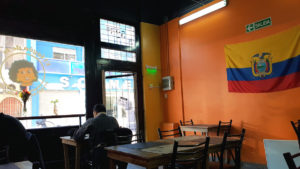
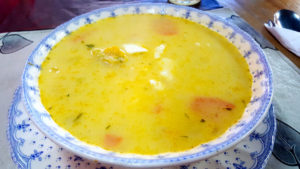
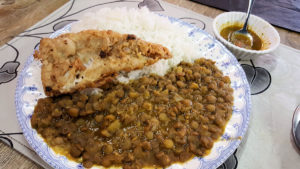

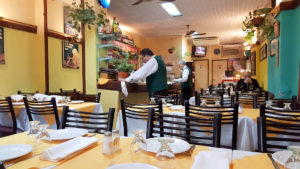
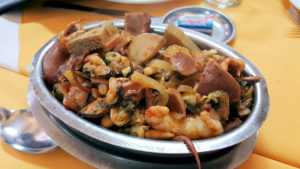
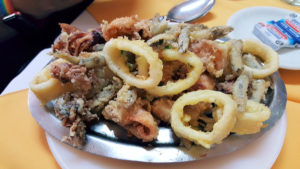
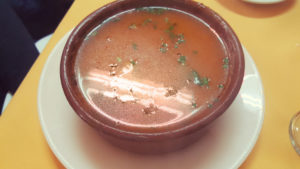
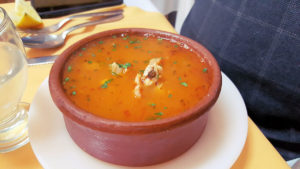
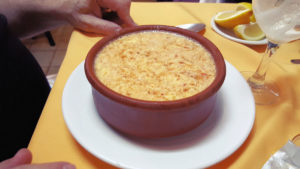
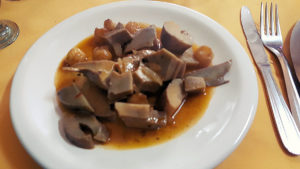
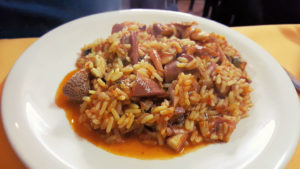
I’m accustomed to seeing machas translated as “razor clams,” usually a la parmesana in Chile. Fresh locos are often hard to find in Chile, because the legal collection season is very short. I had some in Chiloé last April, I believe.
I get the impression that machas can be more generic as to different types of clams. The English version of the menu translates it as scallops, but when I showed the waiter a picture of scallops, clams, or razor clams, he agreed that it was “clams”. The menu also translates cholgas as clams, but he had to agree that we were talking about mussels.
To the best of my memory, I’ve seen it translated as razor clams (It’s “machas,” by the way), though Wikipedia suggests “pink clam” or “surf clam.” Liz Caskey, who’s very knowledgeable on Chilean cuisine, uses razor clam: http://eatwineblog.com/2013/06/28/recipe-baked-razor-clams-with-cheese/
Cholgas are definitely mussels, though Chileans use several other terms including “choritos.” The “choro zapato” is so-called because it approaches the size of your shoe.
The “t” was a typo in the original post that didn’t get caught because it’s also a word and wasn’t flagged and I didn’t spot it – corrected. Liz, by the way, doesn’t say anything about whether machas is used for more than just razor clams, she just mentions that’s what razor clams are called in talking about one particular dish. It may or may not be the case, but since razor clams like that don’t exist here in Buenos Aires, Los Chilenos is using regular clams for the dish, which was the point. And also that they’re not scallops, which is how they translated them on the menu.